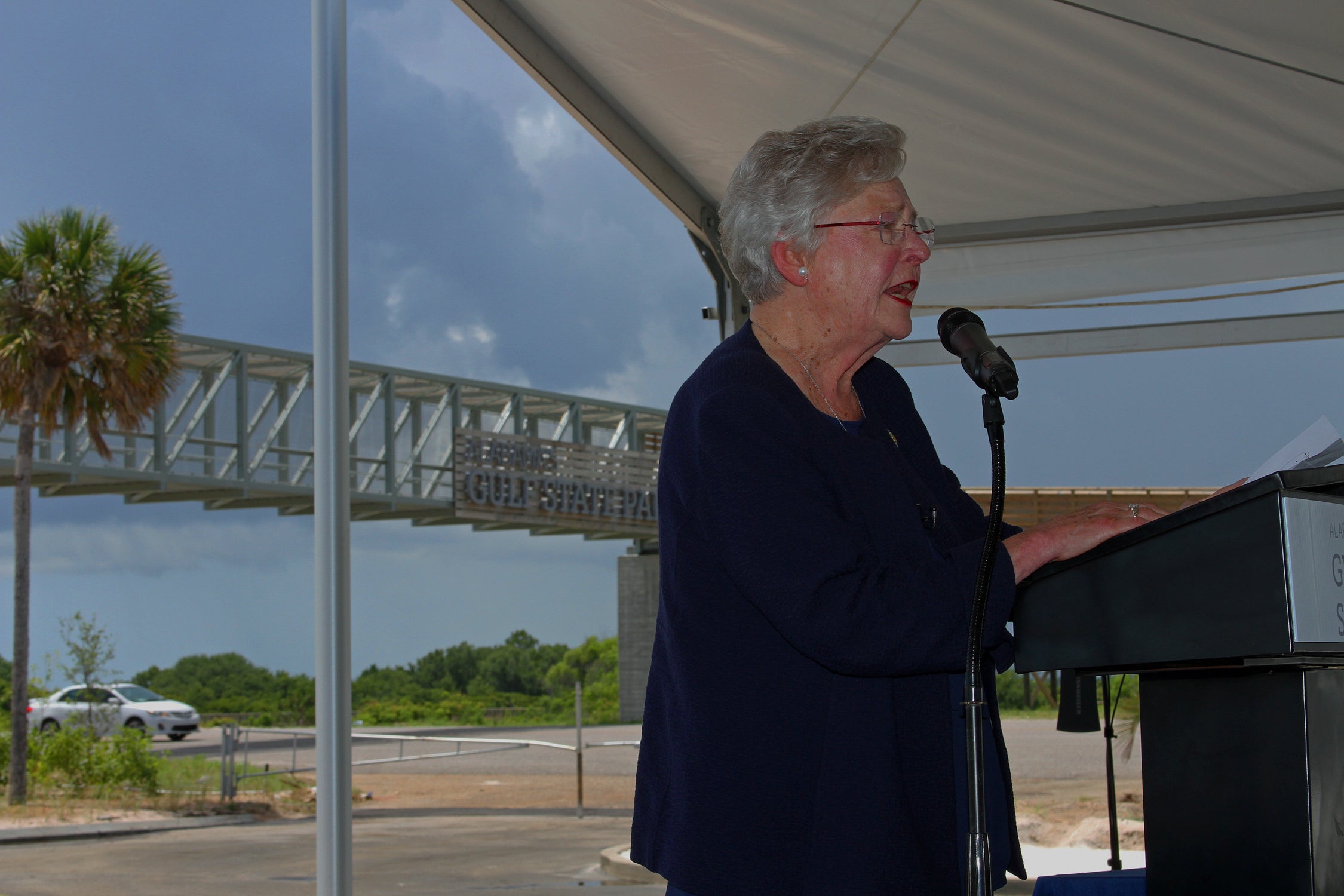By DAVID RAINER, Alabama Department of Conservation and Natural Resources
A glimpse of the rebirth of Gulf State Park’s beachside facilities was revealed by Gov. Kay Ivey last week during an unveiling of the park’s Interpretive Center and East Pedestrian Bridge.
Gov. Ivey, Conservation Commissioner Chris Blankenship and other dignitaries cut the ribbon to the entrance of the Interpretive Center and Pedestrian Bridge, two significant parts of the Gulf State Park Enhancement Project located adjacent to the park’s Beach Pavilion.
As work continues to restore the facilities that were basically wiped out by Hurricane Ivan in 2004, the much-anticipated Lodge and Conference Center are expected to open in late fall of this year.
Blankenship said last week’s dedication was the first of many events that will occur at Gulf State Park to reveal the additions and renovations to this cherished area on the Alabama Gulf Coast.
“I’m sure you have very special memories of your experiences here at Gulf State Park,” Blankenship said. “This is a very special place to me. I’m proud to be the Commissioner of the Department of Conservation and Natural Resources and oversee all our great state parks, including Gulf State Park. That’s one of the highlights of my job.
“I’ve been coming here since I was 3 years old, when we moved to Mobile from north Alabama. I have such great memories of the campground, the beach, the old pavilion and the old lodge and conference center. This is a great place. My daughter was married right out here on the beach. But this park is more than just the beach. At Gulf State Park, we have dunes, lakes, marshes, maritime forests, uplands, pine tree groves, oak bottoms, deer, raccoons, alligators, beach mice, insects like butterflies, and birds of all kinds, including birds of prey.”
In addition to the cabins and cottages, Blankenship listed the activities at Gulf State Park, including camping, hiking, biking, walking, swimming, fishing, boating, crabbing, birding, shelling, golfing, nature education, family gatherings and just relaxing.
For Gov. Ivey, that special status extends the length of the state.
“Alabama is indeed a special place we call home,” Gov. Ivey said. “From the Tennessee Valley, we have the beautiful mountains. In Birmingham, we have world-class food. We see the speed of the race cars at Talladega, and on down to the beautiful waters of the Gulf Coast.
“Let’s be honest. On a day like today, this is where everybody wants to be – in Gulf Shores. There’s no other place on the Gulf Coast that is more perfect and beautiful. That’s the reason we want to protect and continue to grow this part of our state.”
Ivey explained why the Interpretive Center and the East Pedestrian Bridge are crucial parts of the Gulf State Park Enhancement Project.
“Both are important to the public’s access to Gulf State Park and to cementing Gulf State Park as a world-class facility and premiere tourist destination on the Gulf Coast,” Ivey said. “The Interpretive Center will be the launching point for the 28 miles of trails in the park. The Interpretive Center will have a variety of interactive exhibits telling the story of the natural history of this part of the state and how our ecology has evolved over time.
“The Pedestrian Bridge will be one of two bridges here. Visitors and citizens alike have told us loud and clear that we must make it possible to have a safe passage through this beautiful property. The new bridge will provide safe crossing over the East Beach Boulevard and serve as an entrance for the neighbors in Orange Beach and Gulf Shores.”
Ivey said the environmentally sensitive aspects of the buildings and facilities at Gulf State Park set an example for sustainable tourism throughout the world.
Bill Bennett of Valor Hospitality, which is under contract to operate the new additions at Gulf State Park, said the sustainable aspects of the projects will generate about five percent more power and water than what the facilities need to operate. The Interpretive Center has been certified as a Living Building, passing the most rigorous certification process in the world.
“The building is made from materials that are safe for the planet, safe for the people and are all sourced here,” Bennett said. “The Living Building designation is very significant. In January of 2018, there were only 16 Living Buildings in the entire world, and we’re lucky to have one here on the Gulf Coast of Alabama.”








